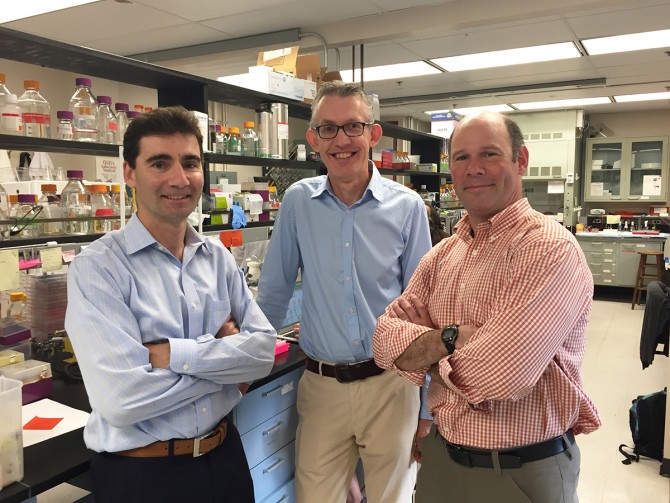A new kind of influenza vaccine: One shot might do the trick
By Tom Fleischman
A seasonal flu shot is a bit like a local weather forecast: Based on the conditions elsewhere and the direction of the prevailing wind, a meteorologist can give the public a pretty good idea of what to expect in the near future. Experts who track influenza’s intercontinental travels basically do the same thing.
“Epidemiologists monitor what strains of influenza are circulating in Southeast Asia. … they usually choose three or four of them, and they predict what the prevailing circulating strains will be,” said David Putnam, associate professor in the Nancy E. and Peter C. Meinig School of Biomedical Engineering.
“Usually they’re right, but sometimes they’re wrong,” Putnam said, “and it changes every year because proteins in the virus mutate.”
But certain proteins in the influenza virus remain constant year after year. And Putnam and Matt DeLisa, the William L. Lewis Professor of Engineering in the Robert Frederick Smith School of Chemical and Biomolecular Engineering, are taking one of those conserved proteins, Matrix-2 (M2), and packaging it in a nanoscale, controlled-release “capsule” in an attempt to create a quick-acting, long-lasting, multi-strain vaccine against pandemic influenza A.
The capsule is a bacterial outer membrane vesicle (OMV), which DeLisa and Putnam have developed collaboratively for several years. The OMV is a membrane-based nanostructure, in this case engineered from nonpathogenic E. coli, whose outer surface mimics the cell from which it originated.
Their paper, “A Single Dose and Long-Lasting Vaccine Against Pandemic Influenza Through the Controlled Release of a Heterospecies Tandem M2 Sequence Embedded Within Detoxified Bacterial Outer Membrane Vesicles,” appears in the journal Vaccine. First author is Hannah Watkins, Ph.D. ’17, now a postdoctoral researcher at the Massachusetts Institute of Technology.
The influenza A virus is a moving target. It changes year to year, and can morph into a pandemic – infectious across a large region – strain that can put the general population at risk. The Putnam-DeLisa team is leveraging the versatility of OMVs, which have shown promise against other deadly pathogens, to create a single-shot vaccine.
The M2 protein is found evolutionarily in the influenza sequence in birds, pigs and humans, so the group took two sequences from birds, one from pigs and one from humans, and assembled them into one multitarget antigen.
“So even if, say, the human strain mutates,” Putnam said, “we know where it came from and it’s going to look like the other two. We kind of covered all the bases.”
In testing, mice infected with the influenza A virus developed high antibody counts just four weeks after vaccination, compared with eight weeks from a typical multishot (prime/boost) vaccine regimen. And the protection was long-lasting: After six months, all of the test mice given the OMV vaccine survived a lethal influenza A infection.
Six months is approximately 25 percent of the typical life expectancy for a mouse, so Putnam thinks it is likely that this OMV-based vaccine would be long-lasting for humans, too.
“Even if we have to give a booster shot every 10 years, like tetanus, that’s still very good,” he said. “Theoretically it should last a long time.”
Additionally, since the vaccine cocktail is encapsulated in a bacterial vesicle, there’s no need for an adjuvant – an agent that’s added to most vaccines to boost the body’s immune response. The immune response is enhanced by the bacteria from which the OMV is derived.
“As a result, formulating and manufacturing of controlled-release OMVs should be more cost-effective,” DeLisa said.
Other contributors included Gary Whittaker, professor of virology in the College of Veterinary Medicine; former postdoctoral researcher Cassandra Guarino; Jose Rios, Ph.D. ’16; and undergraduate researchers Annie Chau ’16, Catalina Pagan ’16 and Hannah Childs ’18, all from the Putnam Group.
This work was supported by grants from the National Science Foundation, the National Institute of Allergy and Infectious Diseases of the National Institutes of Health, and by New York state through the Cornell Center for Advanced Technology.
Media Contact
Get Cornell news delivered right to your inbox.
Subscribe